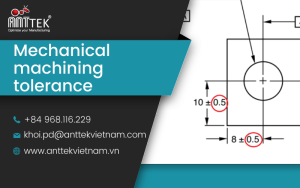What is 6S in Manufacturing?
In the realm of continuous improvement methods, 6S stands out as a powerful approach to enhance organizational efficiency and effectiveness. Drawing on the principles of 6S manufacturing, it surpasses the traditional 5S method by introducing a sixth element: safety. This comprehensive system aims to establish a workplace that is not only well-organized and efficient but also prioritizes employee well-being. In this article, we will take a look into the core concepts of 6S and explore its applications across various industries.
1. What is 6S?
The 6S method is an upgraded version of the 5S method. The 6S is a way of organizing and managing a well-maintained, efficient, high-quality, and safe workplace for employees in any company. The 5S method originated in Japan and was developed by Hiroyuki Hirano. It was first implemented by Toyota in 1970.
The 6S method includes:
- Sort: Remove unnecessary items from the workplace to create a more organized and productive environment.
- Set in Order: Organize essential items in a systematic and accessible way to reduce waste and improve workflow.
- Shine: Maintain tidiness and order in the workspace to promptly identify and resolve problems.
- Standardize: Establish and maintain standardized processes to sustain improvements achieved through the sort, set in order and shine step above.
- Sustain: Instill a culture of continuous improvement to ensure that gains are maintained over the long term.
- Safety: Integrate safety measures and practices into daily operations to protect employee health and prevent accidents.
2. The Implementation of 6S
Implementing 6S is a structured process that involves a combination of planning, training, and ongoing commitment. The following are detailed steps to guide the implementation of 6S in an organization:
2.1. Planning
- Conduct a workplace analysis: Begin by thoroughly assessing the current state of the workplace. Identify areas for improvement in terms of organization, cleanliness, and safety.
- Set goals: Clearly define 6S implementation goals consistent with the overall objectives of the organization, such as improving efficiency, reducing waste, and enhancing workplace safety.
- Create a cross-functional team: Form a team that represents various departments and levels within the organization. This group will be in charge of directing and supporting the implementation process.
2.2. Training
- Employee Training: Provide training sessions to acquaint employees with the 6S Lean principles. Ensure that everyone comprehends the significance of each ‘S’ and how it contributes to overall efficiency and safety.
- Safety Training: Highlight the importance of workplace safety. Train employees on safety procedures, the proper use of equipment, and emergency protocols.
- Promote Ownership: Encourage employees to take ownership of their workspaces and actively participate in the implementation of 6S. Foster a sense of responsibility for maintaining a clean, organized, and safe environment.
2.3. Initial 6S implementation
- Sort: Start by cleaning up your workspace. Identify and eliminate unnecessary items that do not contribute to the work process.
- Set in Order: Arrange remaining items logically and effectively. Implement visual controls, like labels and signage, to guide employees on locating and returning items.
- Shine: Implement a regular cleaning schedule to ensure workspaces are consistently maintained. Encourage employees to tidy up their workspaces upon departure and promptly report any issues.
- Standardize: Develop visual aids and checklists to assist employees in adhering to established standards.
- Sustain: Establish a regular 6S inspection process. Promote a culture of continuous improvement by recognizing and rewarding employees for their contributions to upholding the 6S principles.
2.4. Safe integration
- Identify Safety Hazards: Conduct a comprehensive safety inspection to identify potential workplace hazards. This involves evaluating equipment, processes, and environmental factors.
- Implement Safety Measures: Develop and implement safety procedures to address identified hazards. This may include the utilization of personal protective equipment (PPE), machine safeguards, and improved ergonomics.
- Safety Training: Ensure that all employees are proficient in safety procedures and protocols. Provide ongoing safety education to enhance awareness and compliance.
2.5. Continuous improvement and adaptation
- Continuous Monitoring: Regularly evaluate the effectiveness of 6S practices through testing and receiving feedback from employees. Identify areas for improvement and make necessary adjustments.
- Adapt to Change: As your organization grows, be prepared to modify 6S practices to meet new challenges and opportunities. Flexibility is key to sustaining the benefits of 6S over the long term.
- Encourage Employee Feedback: Foster a culture where employees feel comfortable providing feedback on the implementation of 6S. Act on constructive suggestions to continuously improve and enhance processes.
3. Application of 6S in real-world
Real-world applications of the 6S methodology span a variety of industries, showing its versatility and effectiveness in enhancing efficiency, safety, and overall workplace culture. In next part, you’ll find specific examples illustrating how to apply the 6S principles in different contexts:
3.1. Manufacturing
- Implementing Sort and Set in Order in manufacturing ensures that workspaces are free of unnecessary items, and tools and materials are systematically organized for quick and efficient access.
- Regular equipment maintenance, following the Shine principle, involves implementing a routine cleaning schedule for machinery and equipment. This practice not only ensures their longevity but also reduces the risk of damage and disruption in production.
3.2. Office environment
- Organize your workspace: Apply Sort and Set in Order in your office space, including clearing desks, organizing documents, and creating designated spaces for multiple tasks and different services. This contributes to a more focused and effective working environment.
- Digital organization: The 6S principle can extend to the digital space, encouraging employees to organize computer files, emails, and other digital assets. This can improve information retrieval and work efficiency.
- Employee health: Safety in the office environment may involve an ergonomic assessment to ensure that the workplace is designed to prevent injury and discomfort. Additionally, implementing safety procedures for emergency situations contributes to the overall well-being of employees.
3.3. Industry and Service
- Workspace Organization: In service-oriented businesses, applying the principles of Sorting and Set in order to back-office spaces will contribute to efficient workflows, timely service delivery, and a positive work environment.
- Customer Safety: In industries like hospitality, safety measures are crucial for both employees and customers. This encompasses food safety procedures, proper handling of cleaning chemicals, and emergency response protocols.
6S represents a comprehensive and integrated approach to workplace improvement, amalgamating manufacturing principles with a strong emphasis on safety. By fostering a culture of continuous improvement and prioritizing employee well-being, organizations can attain elevated levels of efficiency, productivity, and overall success. Successful implementation demands commitment, collaboration, and dedication to establish a workplace that is not only productive but also safe and conducive to the health of employees.


















